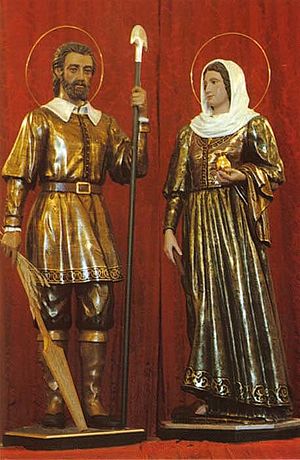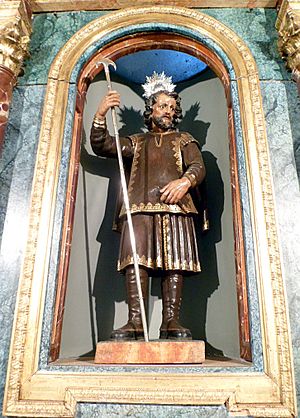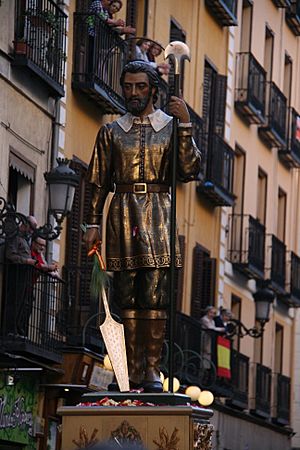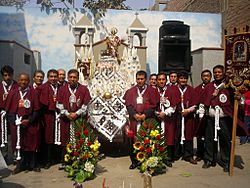Isidore the Laborer facts for kids
Quick facts for kids SaintIsidore the Laborer |
|
|---|---|
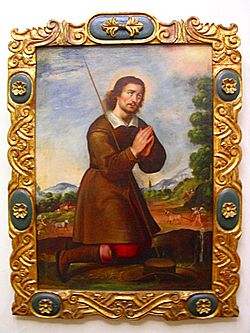
Saint Isidore the Farmer
|
|
| Confessor | |
| Born | c. 1070 or 1082 Madrid, Taifa of Toledo |
| Died | 15 May 1130 (aged 59) or 1172 Madrid, Kingdom of Castile |
| Venerated in | Roman Catholic Church Anglican Communion Aglipayan Church |
| Beatified | 2 May 1619, Rome by Pope Paul V |
| Canonized | 12 March 1622, Rome by Pope Gregory XV |
| Feast | 15 May; 25 October; 22 March |
| Attributes | Portrayed as a peasant holding a sickle and a sheaf of corn, a sickle and staff; as an angel plows for him; or with an angel and white oxen near him. In Spanish art, his emblems are a spade or a plough. |
| Patronage | San Ysidro, San Diego, California ;"San Isidro Labrador, quita el agua y pon el sol" ,'Madrid agriculture; farmers; day labourers; Argentina: San Isidro Chile: Cuz Cuz Peru: Carampa and Lima The Philippines: Pulilan, Bulacan Angono, Rizal Malaybalay City Mantalongon, Cebu Cabaon-an, Ormoc City, Leyte Cuenca, Batangas Digos Brgy. San Isidro, San Pablo City San Isidro, Lupao, Nueva Ecija Lucban, Quezon Anos, Los Baños, Laguna Makiling, Calamba City, Laguna Mogpog, Marinduque Morong, Rizal Nabas, Aklan Bayebaye, Jamindan, Capiz Pulupandan, Negros Occidental Moises Padilla, Negros Occidental Sariaya, Quezon Talavera, Nueva Ecija Tayabas, Quezon San Isidro, Talisay City, Cebu
|
Isidore the Labourer, also known as Isidore the Farmer (Spanish: San Isidro Labrador), was a Spanish farmworker who lived from about 1070 to 1130. He is remembered for his kindness to the poor and animals. He is the Catholic patron saint of farmers and of Madrid. His special day is celebrated on 15 May.
The Spanish word labrador means someone who works the land, like a farmer or a plowman. So, calling him "Isidore the Farmer" is a better way to understand his job. His full name was Isidro de Merlo y Quintana.
Contents
Biography of Saint Isidore
Isidore was born in Madrid around 1070 or 1082. His parents were not rich, but they were very religious. They named him Isidore after their patron saint, St. Isidore of Seville.
Around 1083 or 1085, the city of Madrid was taken over by the army of Alfonso VI of León and Castile. Isidore spent his life working for a rich landowner named Juan de Vargas on a farm near Madrid. He was known for sharing everything he had, even his food, with people who were poor. Juan de Vargas later made him the manager of his whole farm.
Isidore married Maria Torribia, who is known in Spain as Santa María de la Cabeza. They had one son. One time, their son fell into a deep well. It is said that when Isidore and Maria prayed, the water in the well miraculously rose to the ground, bringing their child up with it. Sadly, their son passed away when he was young.
Isidore died on 15 May 1130, in Madrid. Some records say he died in 1172.
In 2022, scientists studied Isidore's body. They found a coin in his throat, which might have been from the time of Henry IV of Castile. The only health problem they found was dental infections, which they think might have caused his death. They estimated he was between 35 and 45 years old when he died, and his height was between 167 and 186 centimeters.
Miracle Stories of Saint Isidore
Isidore loved to go to Mass every morning before work. One day, his co-workers complained to their boss that Isidore was always late. When the boss checked, he found Isidore praying, and an angel was doing the plowing for him!
Another time, his boss saw angels plowing on both sides of Isidore. This meant Isidore was doing the work of three people. People also say that Isidore brought his master's dead daughter back to life. He also made fresh water appear from dry ground to help his thirsty master.
One snowy day, Isidore was taking wheat to the mill. He saw a group of wood-pigeons trying to find food on the frozen ground. Feeling sorry for them, he poured half of his valuable wheat on the ground for the birds. People made fun of him. But when he got to the mill, his bag was full again, and the wheat made twice as much flour as expected!
Isidore's wife, Maria, always kept a pot of stew ready because Isidore often brought hungry people home. One day, he brought more people than usual. Maria said there was no more stew. But Isidore told her to check again, and she found enough stew to feed everyone.
On 2 April 1212, after heavy rains, Isidore's body was found in a cemetery. It was said to be perfectly preserved.
It is also believed that he appeared to Alfonso VIII of Castile. He showed the king a secret path to surprise his enemies, the Moors, and win the battle of Las Navas de Tolosa in 1212. Later, when King Philip III of Spain got better from a serious illness after touching Isidore's remains, the king replaced the old container holding his remains with a fancy silver one. This helped start the process of making him a saint. Other royal family members also sought healing from the saint.
It is said that 438 miracles have been linked to him. The oldest book about his life, written in the 1300s, tells five of his miracles:
- The story of the pigeons and the grain.
- The angels plowing for him.
- How he saved his donkey from a wolf attack through prayer.
- The story of his wife's pot of food.
- A similar story about him feeding a group of people.
The book also says his body was found perfectly preserved 40 years after he died.
Veneration of Saint Isidore
Isidore was declared "blessed" (beatified) in Rome on 2 May 1619 by Pope Paul V. He became a saint (canonized) almost three years later by Pope Gregory XV, along with other famous saints like Ignatius of Loyola and Teresa of Ávila, on 12 March 1622.
In 1696, his remains were moved to the Royal Alcazar of Madrid to help Charles II of Spain get well. While there, the king's locksmith took a tooth from the body and gave it to the king, who kept it under his pillow.
In 1760, his body was brought to the Royal Palace of Madrid when Maria Amalia of Saxony was sick.
In 1769, Charles III of Spain had the remains of Saint Isidore and his wife Maria moved to the San Isidro Church, Madrid. The special container for his body has nine locks, and only the King of Spain has the main key. The container can only be opened by the Archbishop of Madrid with the king's permission. Because of this, it has not been opened since 1985.
His feast day is celebrated on 15 May in the Catholic Church and in the Philippine Independent Church.
Patronage of Saint Isidore
Saint Isidore is widely honored as the patron saint of farmers, peasants, day laborers, and agriculture. He is also the patron saint of bricklayers. His hometown of Madrid, and other cities in Spain like Leon, Zaragoza, and Seville, honor him as their patron saint. Many places that used to be part of the Spanish Empire also honor him. The US National Catholic Rural Life Conference also sees him as their patron. Places like San Ysidro, California, and San Ysidro, New Mexico, are named after him.
Iconography of Saint Isidore
Saint Isidore is often shown as a farmer holding a sickle (a curved blade for cutting crops) and a bundle of corn. He might also be shown with a sickle and a staff. Sometimes, an angel is seen plowing for him, or an angel and white oxen are near him. In Spanish art, his symbols are a spade or a plow.
Legacy of Saint Isidore
The story of Saint Isidore reminds us that all work is important and that ordinary life can be a path to holiness. Stories about angels helping him show that his work was never ignored and his duties were always completed. Saint Isidore's life teaches us that if you keep your spiritual life in order, your daily tasks will also fall into place.
His master Juan de Vargas's house in Madrid is now a museum called the "Casa de San Isidro." It shows exhibits about Madrid's history and the saint's life. This museum is different from the San Isidro Church. The museum has a chapel built where Isidore lived and died, and it also has the well where his son fell and was saved.
Feast Day Celebrations and Festivals
His special day, 15 May, is celebrated in many countries and places. Many towns honor Saint Isidore and his wife Blessed María Torribia with parades where fields are blessed.
Spain
One of the most famous holidays in Madrid is on 15 May, Saint Isidore's feast day. He is the patron saint of the city and of farmers. The traditional festival happens in an open area called the Pradera del Santo. In the afternoon, statues of San Isidro and his wife, Santa María de la Cabeza, are carried through the streets.
The festival in honor of San Isidro is a very important celebration in the province of Malaga. It is very popular in Alameda because San Isidro is one of the town's patron saints.
Celebrations for both saints are also held in other parts of Spain. In Castalla, a town in Alicante, they have the Fair of San Isidro. Many companies show their products in a fun, festive way. A medieval market and rides are especially popular.
The Romería festival in Almogia, a village between Malaga and Antequera, celebrates San Isidro, its patron saint. This happens on a weekend in mid-May with a carnival. Floats from nearby farms, with people dressed in traditional flamenco dresses and riders on dancing horses, sing and dance from Almogia to the Romería ground. The festival includes music, horse races, and a special bar for horses and their riders. The best-decorated float wins a prize.
Chile
15 May is San Isidro Day in Cuz-Cuz, near Illapel, Chile. If the day is a Monday, the celebration happens on the following Sunday. Celebrations start at noon with a Mass, followed by a parade and Chilean dances.
Nicaragua
In San Isidro, Matagalpa, the town celebrates its patron saint from 1 to 15 May.
Peru
The people of San Isidro de Carampá in Ayacucho, Lima, celebrate a San Isidro festival. The First Society of San Isidro de Carampá organizes the festival. In the evening, after Mass, a parade goes to the Adornante's house. The next day, another Mass is held, followed by another parade and a festival.
Philippines
Many festivals are held to honor Saint Isidore around 15 May in the Philippines, which is mostly a farming country and mostly Catholic.
- The Sikoy-Sikoy Festival in San Fernando, Cebu, is a sea festival honoring St. Isidore the Farmer. It celebrates the rich sea life of San Fernando. It is held every Sunday before May 15. The festival includes prayers for good farm and sea harvests.
- The Apit Festival of Allacapan, Cagayan, is a celebration of thanks for the year's harvest. It is celebrated from 10–15 May.
- The Sabugan ng Biyaya Festival (or Sabugan Festival) of Agdangan, Quezon, is a thanksgiving event for the town's blessings.
- The Pahiyás Festival is held in Lucban, Quezon, to thank Saint Isidore and Blessed María for a good harvest. Houses are decorated with farm products, which are later given away.
- The Kangga Festival is held on his feast day in Mogpog, Marinduque. The festival celebrates farming traditions and gives thanks for good harvests and the town's success.
- The Bariw Festival in Nabas, Aklan, is held every 12–15 May. Saint Isidore is the town's patron. The festival also shows off the town's bariw products like hats and mats.
- In Pulilan, Bulacan, carabaos (water buffalo) are often dressed up or painted. They are trained to kneel before the Church of San Isidro Labrador during the festival. This unique custom is a way to show respect to the saint.
- Saint Isidore is celebrated in the towns of San Isidro and Talavera, Nueva Ecija. This province is known as the "Rice Granary of the Philippines." Celebrations start a week before the feast day with daily prayers, Masses, parades, and a funfair (perya).
- Barangay San Isidro in Lupao, Nueva Ecija also celebrates Saint Isidore as its patron saint.
- Roxas, Talugtug, Nueva Ecija in Talugtug, Nueva Ecija also celebrates Saint Isidore's feast for 15 days until 15 May at the Church of Iglesia Filipina Independiente.
- Saint Isidore's feast is also celebrated in Lezo, Aklan every 14–15 May.
- Barangay Teguis in Poro, Cebu celebrates Saint Isidore's feast on 15 May and the day after.
- The towns of Tubigon, San Isidro, and Bilar in Bohol celebrate Saint Isidore's feast day on 15 May.
- Sitio Canipa-an in Barangay Banquerohan, Cadiz, Negros Occidental, also celebrates the feast every May. The first time the saint was honored there was in 1918.
- In Pampanga, the Feast of San Isidro is celebrated every 15 May in different villages. City of San Fernando, Bacolor, Macabebe, and other towns have villages named after the saint.
- In Hinunangan, Southern Leyte, Barangay Calag-itan and Barangay Catublian, as well as Silago, honor Saint Isidore. These places belong to the Iglesia Filipina Independiente, a church that separated from the Catholic Church after the Philippine Revolution.
- In Barangay Salawag, Dasmariñas, the Feast of San Isidro is celebrated along with another feast. Saint Isidore is the main patron of the village.
- Saint Isidore is the Patron Saint of Barangay San Roque and the second patron saint of the whole town of Naic. On May 15, the town celebrates the BIHISAKAHAN Festival, where local dishes and products are displayed and shared.
- Saint Isidore's feast is also celebrated in some places in Northern Samar, especially in the town of Palapag, where many villages honor Saint Isidore the Farmer as their patron saint.
- Saint Isidore the Farmer is the Patron Saint of Zamboanguita, Negros Oriental, and its feast day is on 15 May.
- San Isidro Labrador Parish in Las Pinas City celebrates its feast day every year on 15 May.
- San Isidro Labrador is the Second Patron of the Diocesan Shrine of the FIVE WOUNDS of Our Lord Jesus Christ Parish. A chapel dedicated to San Isidro in Carmencita Admiral was the first chapel in Las Pinas under the Archdiocese of Manila dedicated to San Isidore. Both the Shrine and the chapel celebrate the saint's feast day every 15 May.
- In Lumban, Laguna, five of its sixteen villages have San Isidro Labrador as their patron saint. The parish celebrates their feast days on different dates: May 15 for Brgy. Lewin and Brgy. Wawa, May 20 for Brgy. Maytalang 1, May 22 for Brgy. Caliraya, and the 2nd Sunday of May for Brgy. Maytalang 2.
United States
In 1947, Saint Isidore was officially named the patron of farmers in the United States. His feast day was set for 10 May in all US dioceses. Later, with changes to the church calendar in 1969, Saint Isidore's feast day was moved back to 15 May. In some places in the US and Canada, his feast is celebrated on 25 October, and some traditional Catholics keep the 22 March date.
Corrales, New Mexico
In Corrales, New Mexico, the town celebrates the San Ysidro Feast day on 15 May. Matachines (traditional dancers) dance through the streets, and the festival is a big part of the city's celebrations.
See also
 In Spanish: Isidro Labrador para niños
In Spanish: Isidro Labrador para niños
- Saint Isidore the Laborer, patron saint archive


